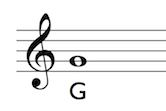How to read any note of music

Have you ever found yourself looking at a music chart and wishing you could make sense of it?
Well, it might be a lot easier than your grade school music teacher made it seem.
Your difficulty may have started with those mnemonic devices that were supposed to help.
‘Just use these four simple sayings,’ your teacher said:
1. FACE
2. All Cows Eat Grass (or is it All Cars Eat Gas, or All Cars Eat Gassy Cows?)
3. Good Boys Do Fine Always
4. Every God Boy Does Fine (or Deserves Fudge)
Then, you would just wait for your music teacher to remind you which one goes with the Treble Clef and which for the Bass Clef, and which is for lines or spaces on the staff.
Even if you could manage to keep them straight, there is always the issue of reading pitches above or below the staff.
I think there’s a simpler way.
Clefs with useful names
We have to start with the clefs. While we have traditional names like Treble and Bass, they aren’t very useful. If we give them the alternate names “G Clef” and “F Clef,” we have something informative. See, each clef points to and locates a particular note on the staff. The G Clef circles around the second line and shows us where the G note is. The F Clef has a large dot and two small dots centered around the fourth line and shows us where the F note is.


From there, we just have to remember two simple principles:
1. Notes move up and down the staff according to the musical alphabet, A through G.
2. Step-wise motion on the staff follows a line-space-line-space pattern.
It’s as simple as that. Check out the video for the 4-minute explanation.

